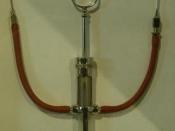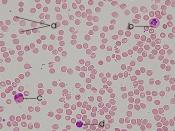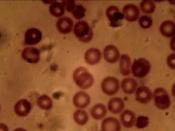A December 1998 article in "Jacksonville Medicine" tells a peculiar story comparable to science fiction yet true to history. In the middle of World War II, United State's scientists, stationed in the Alamo desert, struggled to develop the hydrogen bomb. To complete the bomb, they needed a chemical that prevented any kind of reaction with other molecules. By substituting fluoro compounds for the hydrogen in carbohydrates, they created the key ingredient: perfluorocarbons. However, one scientist, Dr. Leland Clark, was so impressed with the oxygen-carrying capability of the compound that he continued experimentation in the realm of medicine "" not chemical science. Today, we're going to take a look at these perfluorocarbons to see their amazing medical applications by, first, seeing what exactly PFCs are, next, looking at ways they are used, and, finally, examining the costs and benefits of using the compound.
Perfluorocarbons are synthetic compounds used as oxygen carrying agents in blood.
According to the previously mentioned issue of "Jacksonville Medicine", Dr. Bruce J. Leone of the Mayo Clinic in Jacksonville, FL explains that in human blood, proteins known as hemoglobins carry oxygen to the body's tissues at a rate of 22%, in other words, they deliver only 22% of the oxygen in their cells to our body's tissues.
In the event of tissue damage, the oxygen carrying capability of the hemoglobins is reduced to even lower capabilities. Perfluorocarbons attract and restrain gaseous molecules, like oxygen, at a greater rate than hemoglobins. The introduction of the compounds into the blood stream increases oxygen delivery to 100%.
Dr. Olivier Cuignet of Saint Luc University, in a Department of Anesthesiology Abstract in October 1999, states that PFCs are highly soluble in water, so can be evenly distributed throughout the blood. Once the compound is introduced into the blood stream, they attract oxygen and carry the molecules to tissues, just as hemoglobins would. However, unlike a natural protein, PFCs are not metabolized or re-circulated into the blood stream. After completing their circulatory cycle, the compound is collected in the liver and spleen and is breathed out of the body as a vapor approximately one week after introduction to the blood stream.
Dr. Cuignet's article goes on to explain that the unique aspect of PFCs is their interactions with other chemical compounds. They lack chemical toxicity so are not affected when combined with other compounds in a solution. When introduced in the blood, though, they do not act on the coagulation, immunity or any other properties of blood. PFCs simply attract oxygen and are more appropriately referred to as oxygen carrying agents.
As previously mentioned, PFCs were produced during World War II, but extensive medical studies of the compound came later in the mid 1960's by Dr. Leland Clark of Synthetic Blood International. As with any chemical, the boiling point was unstable. Before the product could be used for medical purposes stability had to be confirmed. The first PFC test conducted on a live animal, using the stable compound, was in 1966 by Dr. Clark. He submerged a live mouse into a liquid solution of oxygenated PFC. Left for over an hour, the mouse stayed alive, surviving with no damages. The experiment was a success and new uses for the compound were discovered.
Now that we understand how perfluorocarbons operate, let's examine these purposes for which they can be used. A January 2000 issue of "Applied Cardiopulmonary Pathophysiology" reports two major functions for which the compounds can be used: intravenous blood emulsions and liquid ventilation. Again, because PFCs are not considered synthetic blood substitutes, both functions act as modifications of oxygen carriers.
The first use, intravenous emulsions, is an all-purpose product administered into the body through the veins as an emulsified solution. The PFC microdroplets in the solution are 1/70th the size of red blood cells and can therefore reach many areas of the body that human red corpuscles cannot, significantly increasing oxygen-carrying capability to the lungs. A Synthetic Blood International press release from May 22, 2000 stated the increase in this oxygen delivery also allows for correction of tissue damage caused by a stroke because it immediately re-circulates the blood.
The second use for perfluorocarbons is liquid ventilation. A pure liquid PFC solution is administered into the lungs through a ventilator. Upon dispersement, the solution acts as a surfactant, in other words, a highly water-soluble solution which creates a highly effective medium for gas exchange, thus increasing lung function and the diffusion of oxygen.
An excellent example of liquid ventilation is found in the 1994 film, "The Abyss", directed by James Cameron. To explore great depths of the ocean, the oxygen in the diver's lungs was replaced with the oxygen-carrying perfluorocarbon solution. The scientists were able to breath and function underwater with no harm. While this example is just a movie, the liquid ventilation process was the same as in the previously mentioned mouse experiment where the animal breathed the solution with no complications.
Liquid ventilation is used for more than just rats and deep-sea divers! A December 27, 1998 article in "London Times" tells that liquid ventilation can serve as a cure for respiratory malfunction. Two adult lung diseases, adult respiratory dysfunction and chronic obstructive pulmonary disease, affect over ten million people annually. In children, lung hypertension affects 80,000 babies each year. The article states that liquid ventilation provides improved oxygen distribution to the damaged lung tissues, serving as a remedy.
We have taken a look at the operation of perfluorocarbons and two major purposes for which they are used, so now we must play a little weighing game, looking at the cost and benefits of the product. Starting off, when looking at the cost of this synthetic compound, the physical effects must be viewed. The previously mentioned Dr. Cuignet warns that PFC emulsions have the potential of forming a liquid embolus. Since these emulsions are injected intravenously, possible reactions can cause the often-fatal traveling blood clot to form. Another cost issue is related to the evaporation of the solution from the body. As previously mentioned, PFCs vanish from the system after several days, so the treatment is a one-time use. Subsequent applications must be administered to continue the positive effects. Finally, PFC use can be abused. An October 18, 1998 article in "New York Times" claims that several cross-country skiers, speed skaters, and cyclists illegally used the oxygen-carrying compound at the Winter Olympics in Nagano, Japan. Dr. Martial Saugy of Lausanne University explains that the PFC compound provides a significant increase in oxygen delivery to the muscles, a benefit desired by any athlete. But improper administration and regulation allows for dangerous complications. Unfortunately, PFCs cannot be detected in the blood stream unlike alternative drugs, which makes its appeal even greater for eager athletes.
On the flip side, however, there are many benefits in using these PFC. We have already seen that the two purposes of the compound provide specific remedies to dangerous conditions, but further advantages have been discovered. An August 28, 2000 Press Release from Synthetic Blood International maintains that by the year 2030 donor blood supplies will decrease by four million units each year. Scientists have struggled to create a human blood substitute to preempt the decline, but the key is synthesizing hemoglobins. Perfluorocarbons accomplished the task that synthetic hemoglobins cannot "" carrying substantial amounts of oxygen - and have been used in medical situations to do just that. Even more significant is that PFC solutions are sterile and can be stored at room temperature. This long-lasting capability allows for doors to be opened for future military and emergency situations. A March 2000 issue of "Medical Device and Diagnostic Industry" magazine lists a number of additional benefits. The article maintains that acute carbon monoxide poisoning can be treated with the use of PFCs. Also, pretreatment in cancerous tissues with perfluorocarbons before radiation or chemotherapy treatment aids in breaking down a tumor by diffusing the cells. Finally, the cost of PFCs is also inexpensive because the solution is processed and packaged in a standard small volume parenteral facility, so no complex manufacturing technology is needed. Synthetic Blood International currently has a contract to create these products in a practical and cost-effective manner.
Today we have examined perfluorocarbons, looking, first, at what exactly they are, next, the purposes for which they are used, and, finally, both the costs and benefits behind their uses. The medical advancements made by these PFCs are so ironic to its once destructive origin. A synthetic compound discovered by chemical scientists to aid in the destroying of lives, has now been found to actually save lives.





